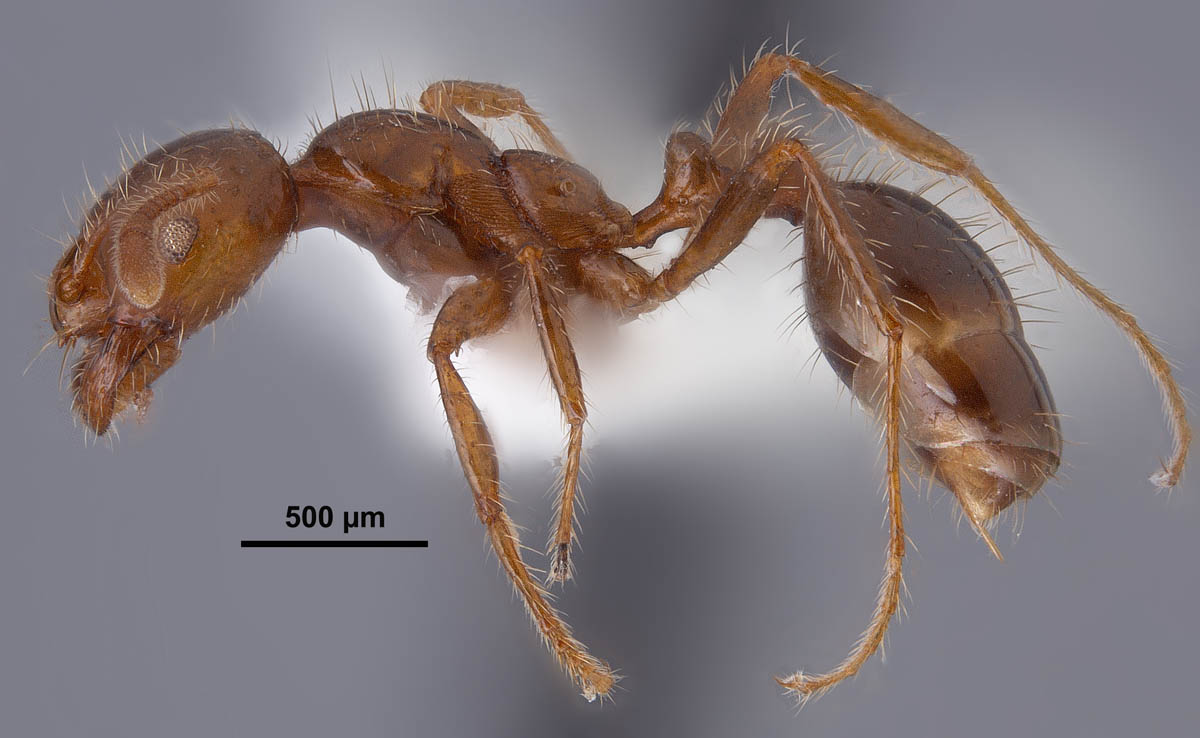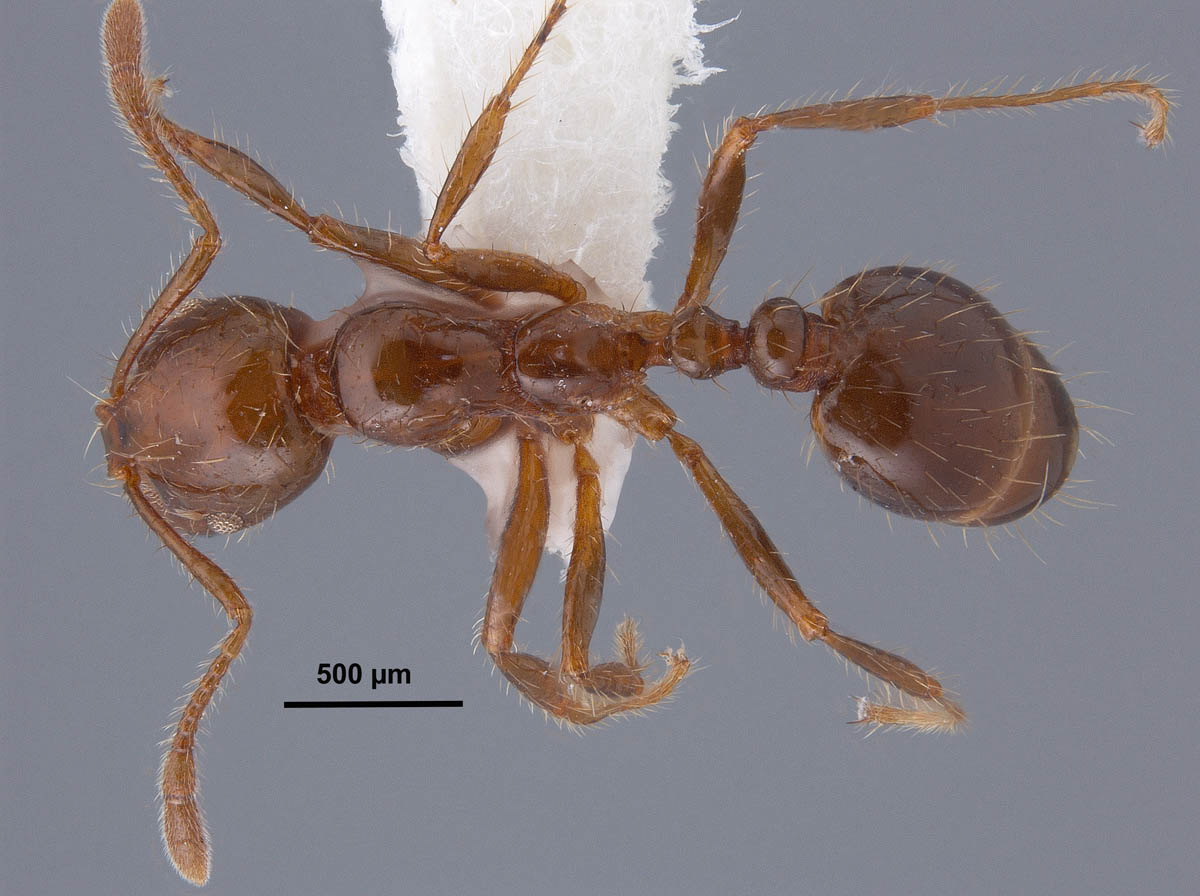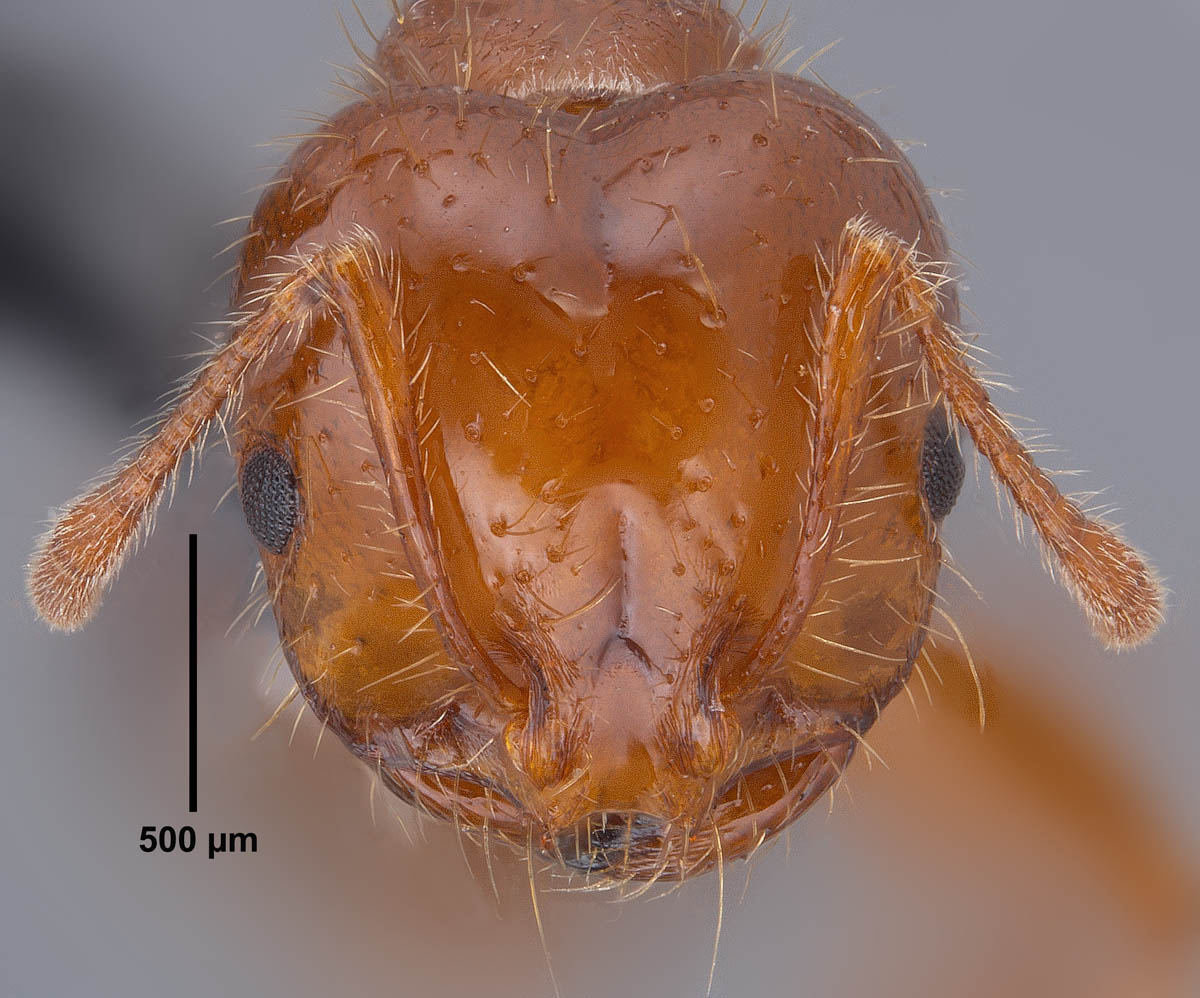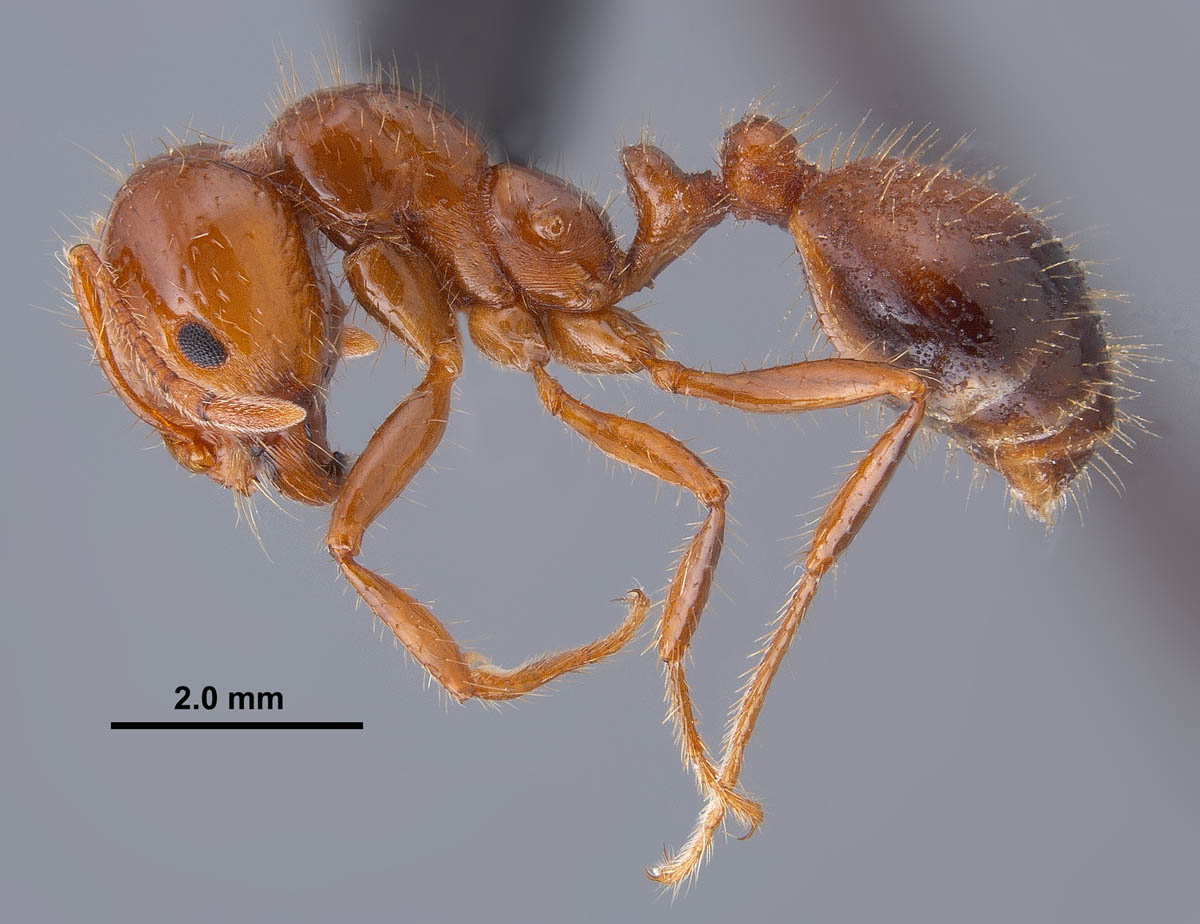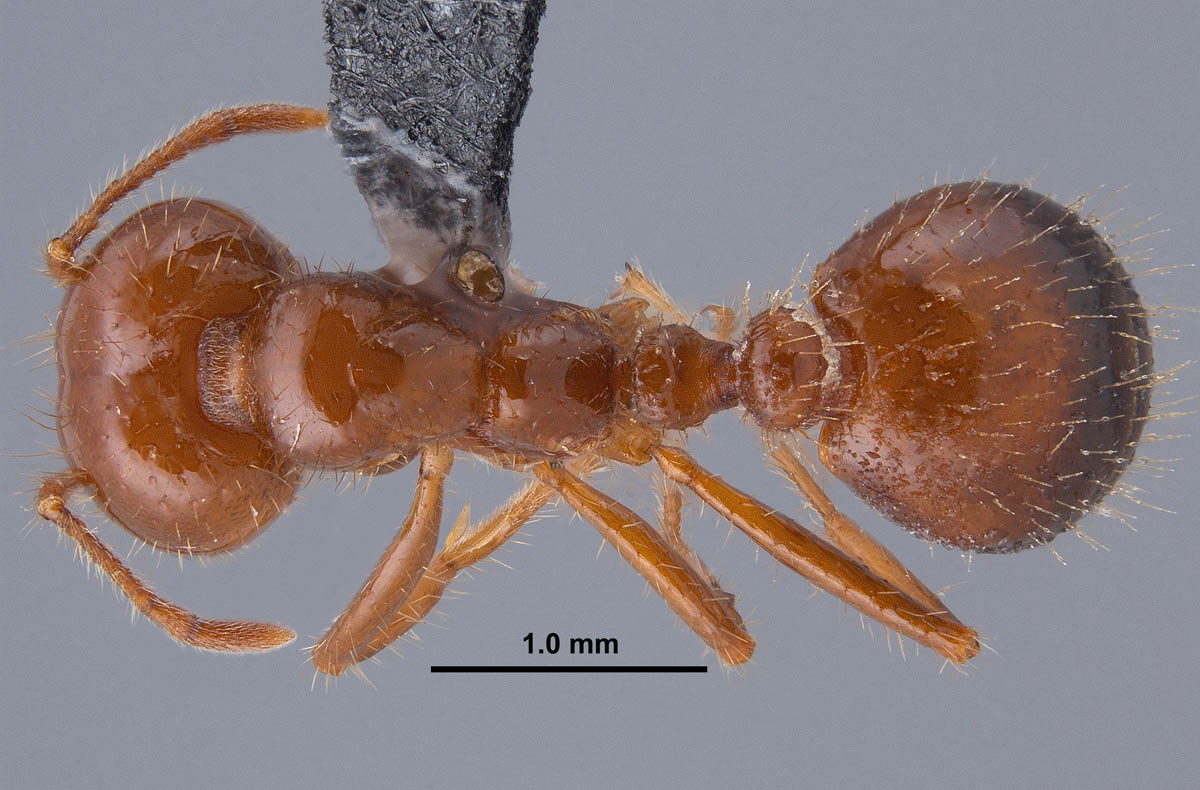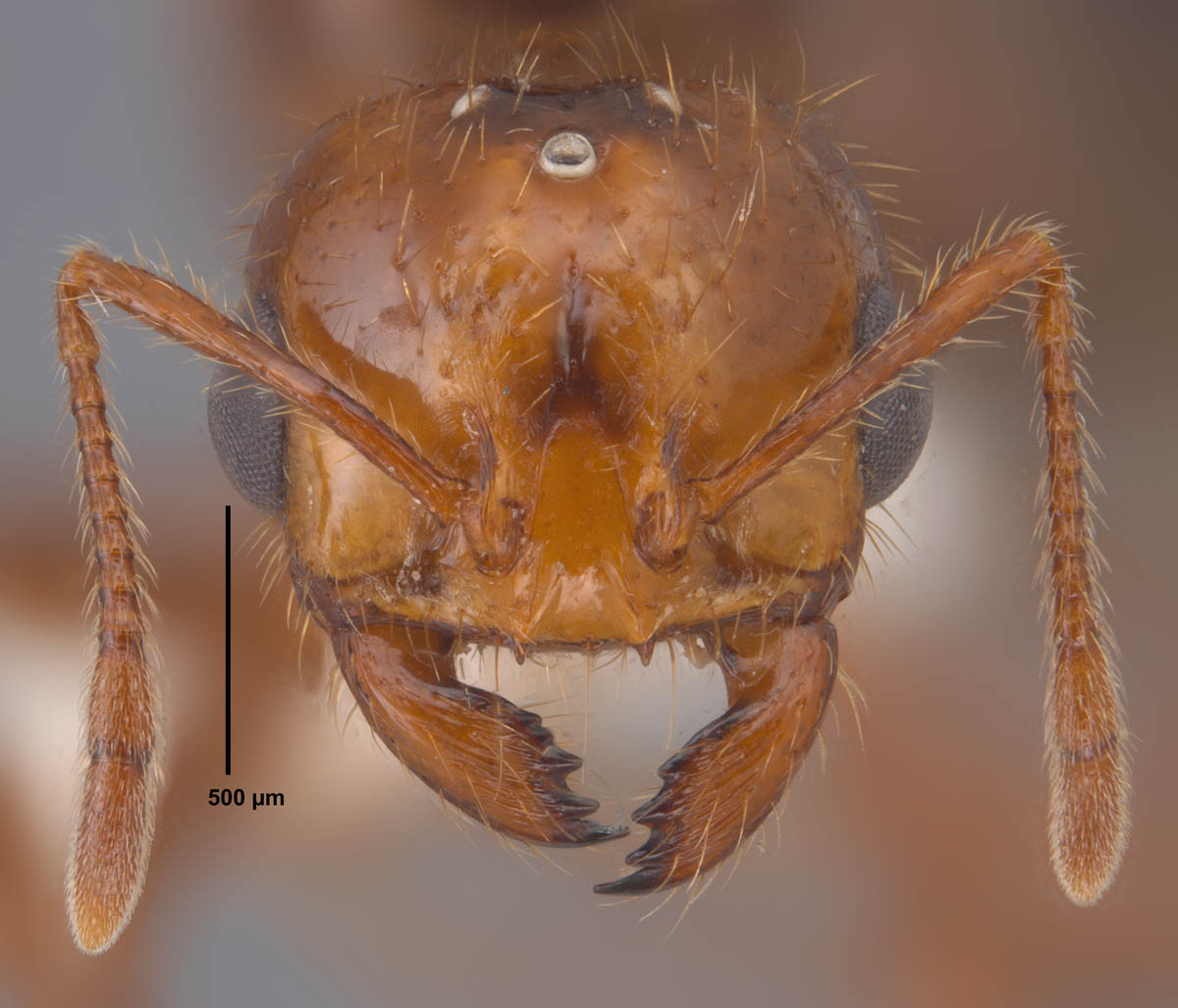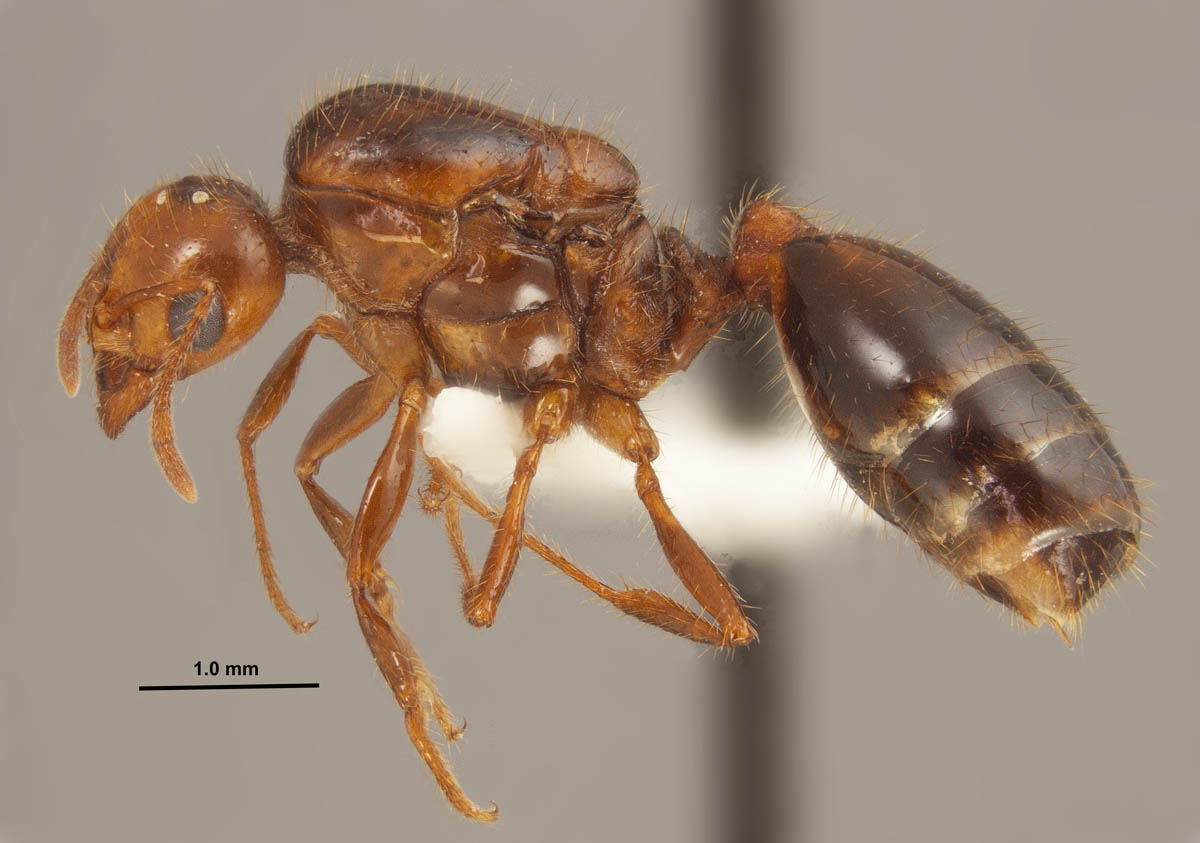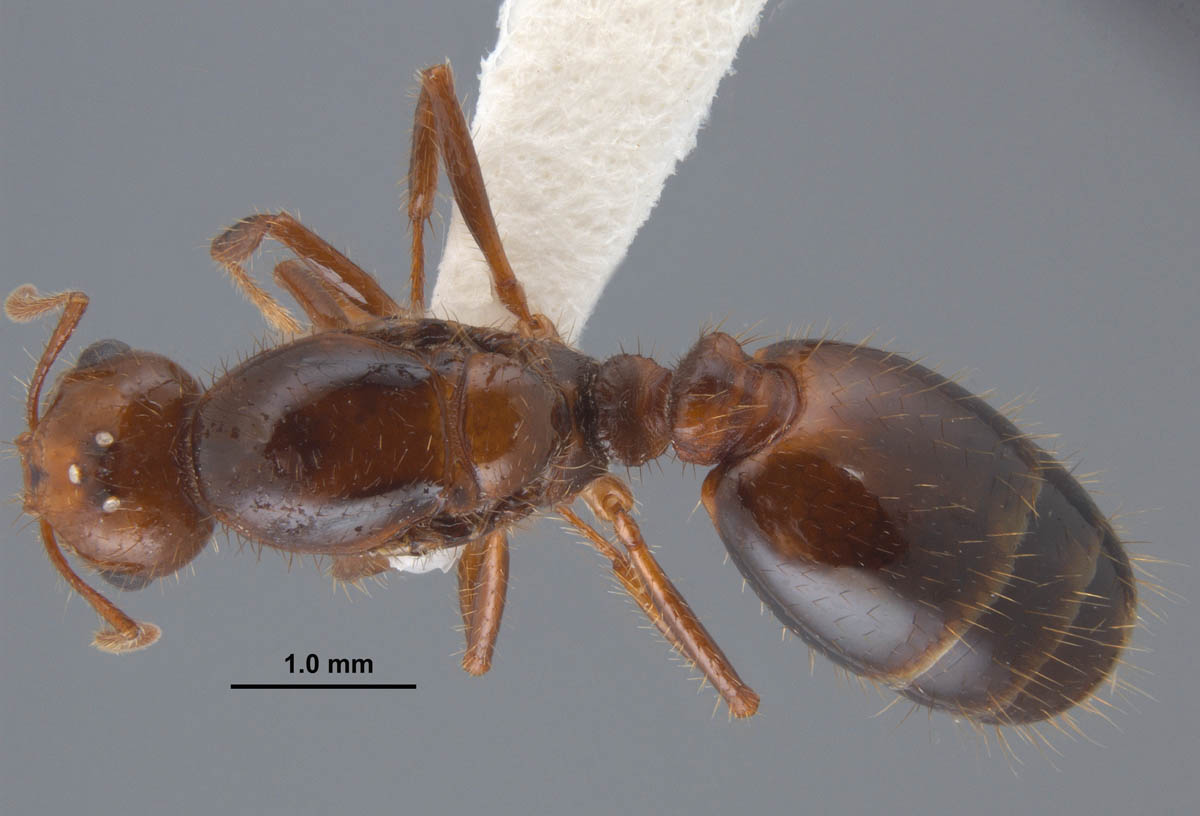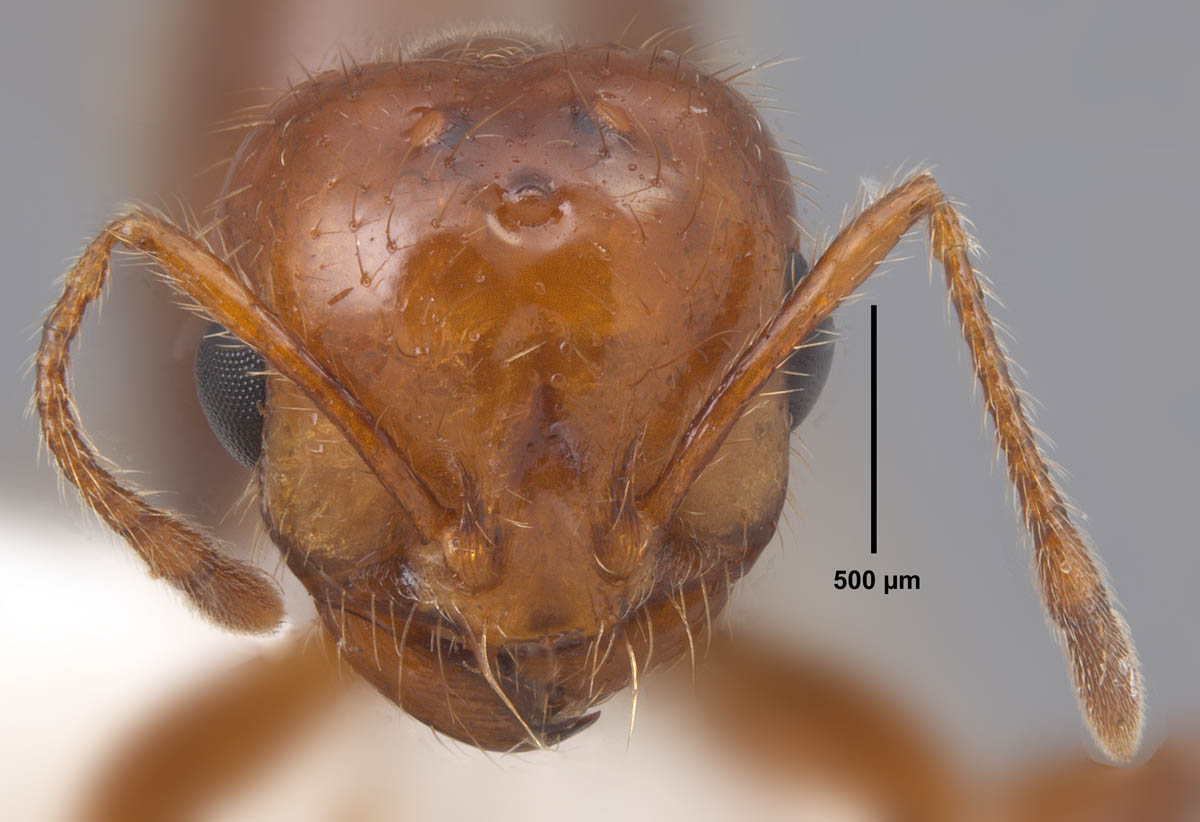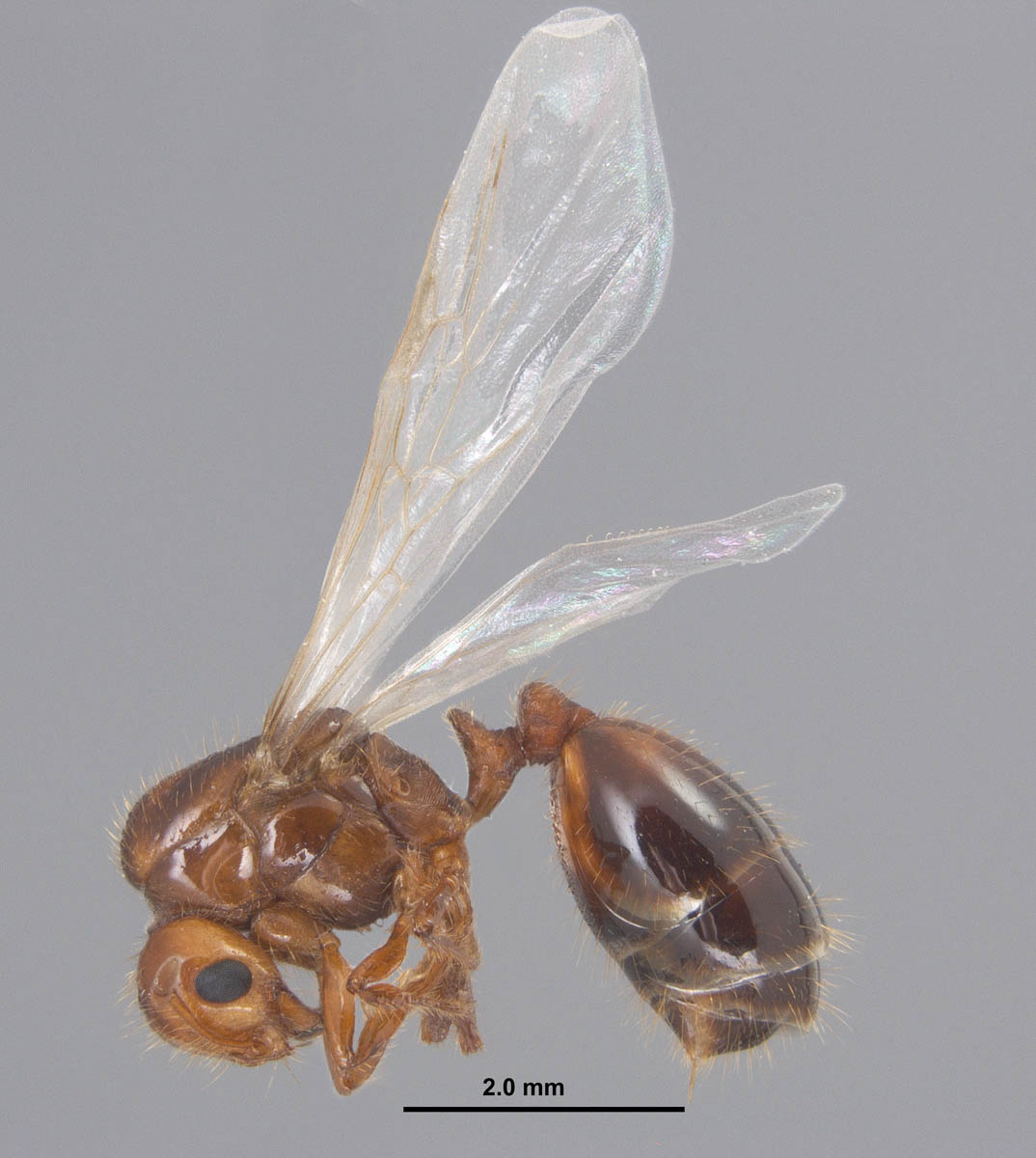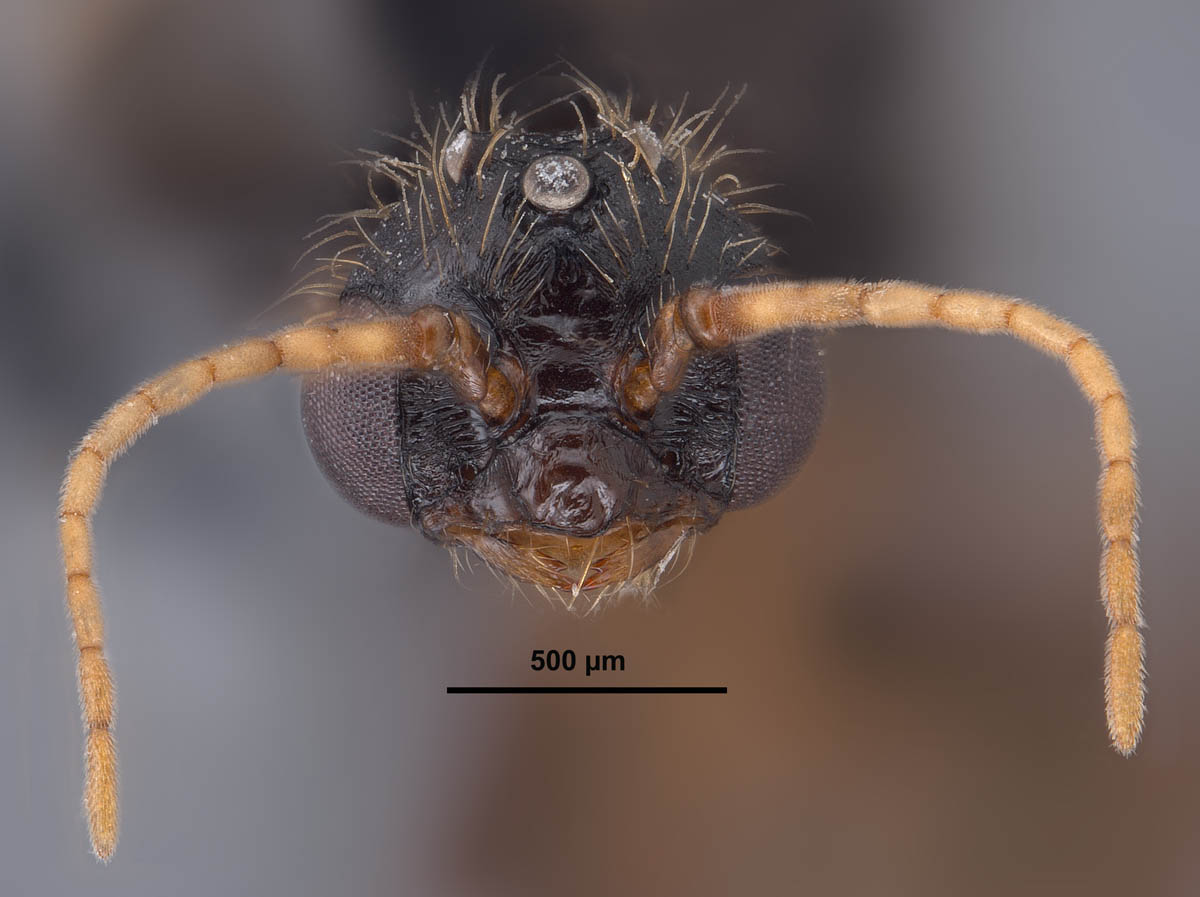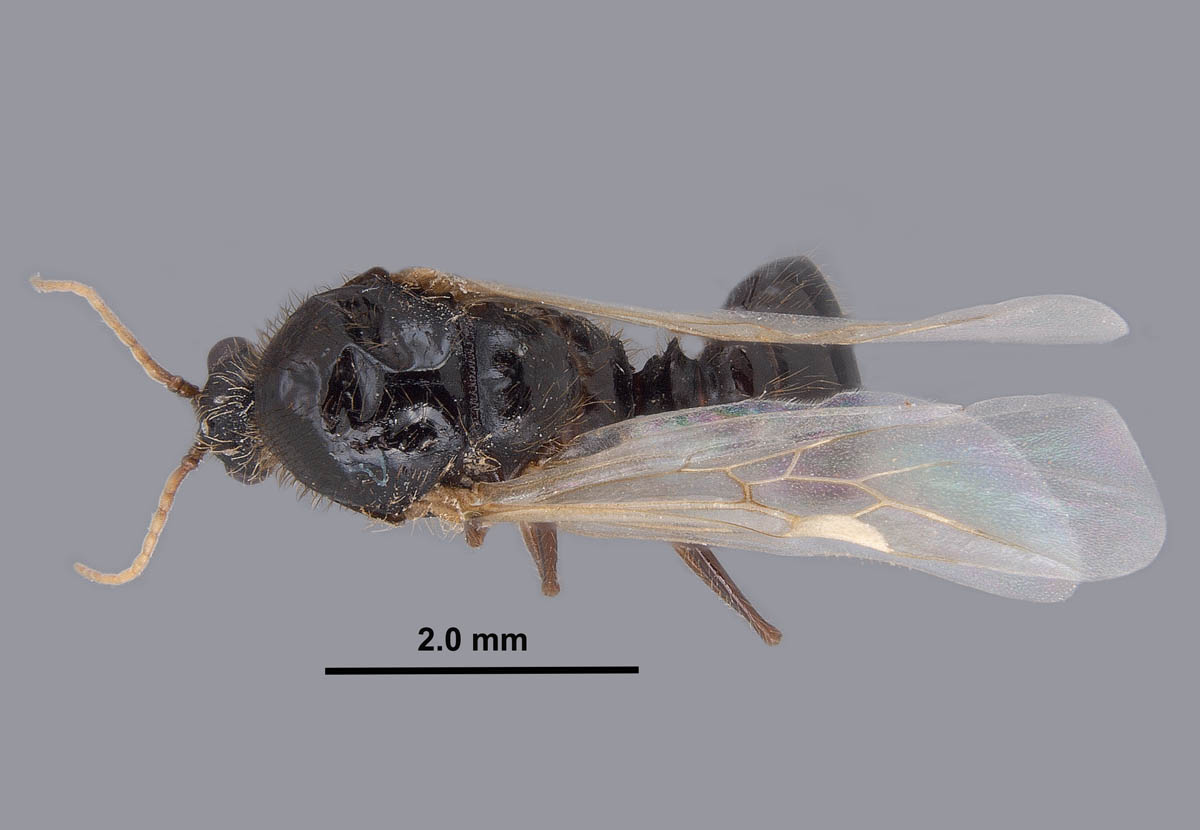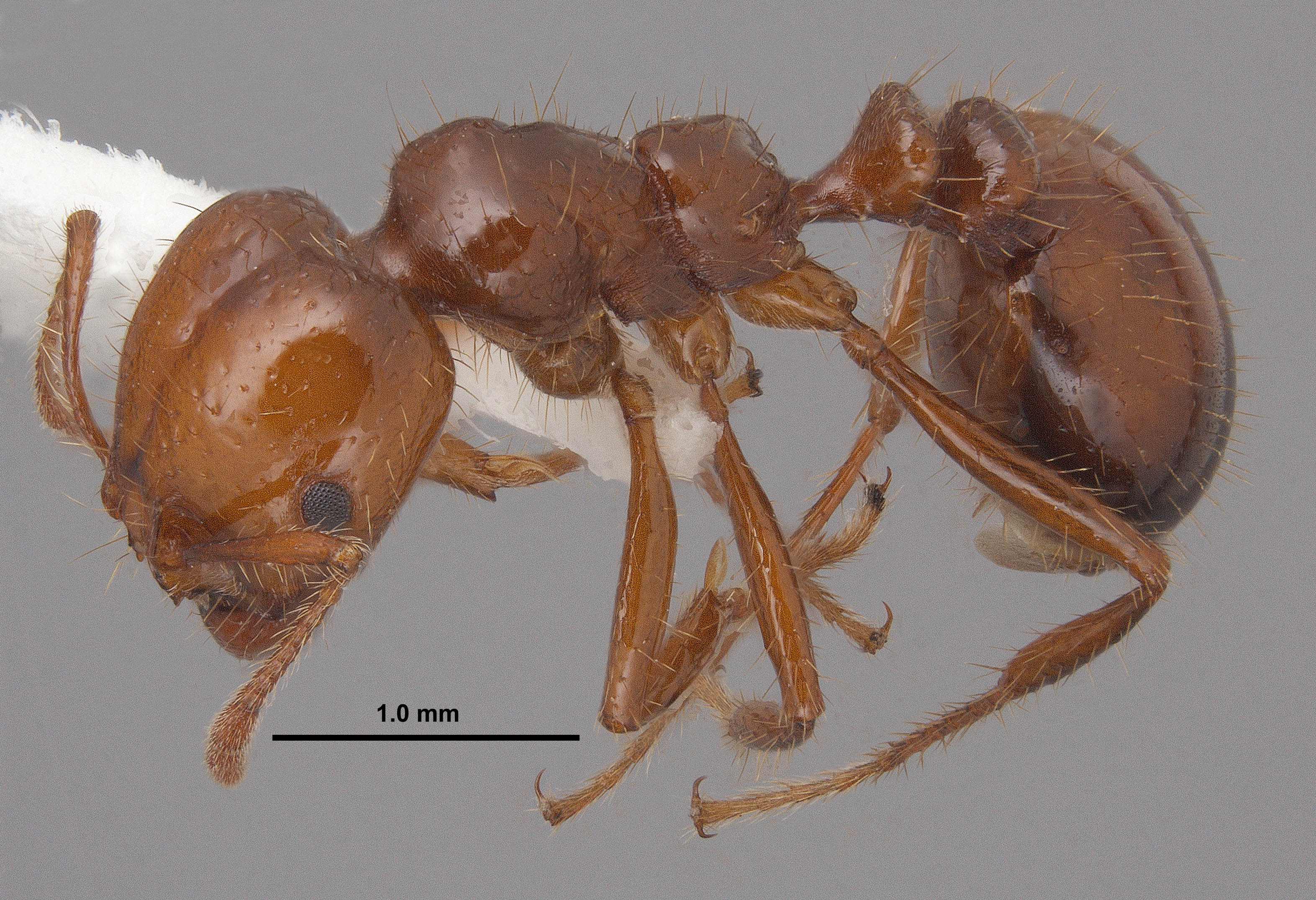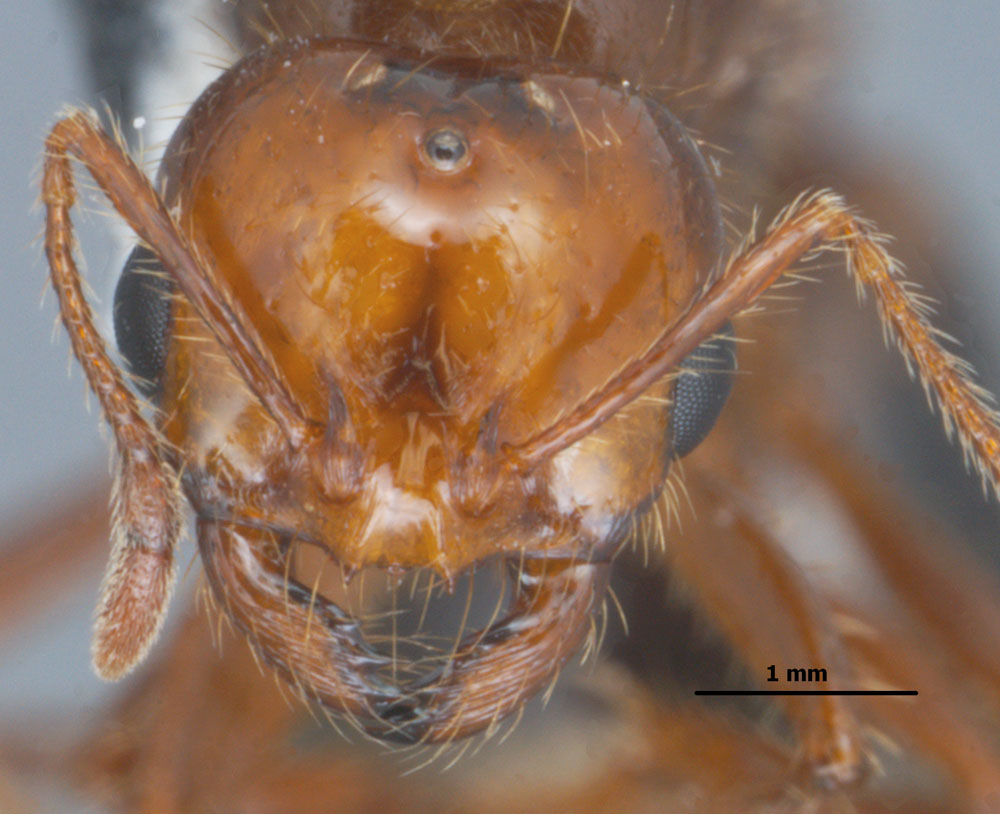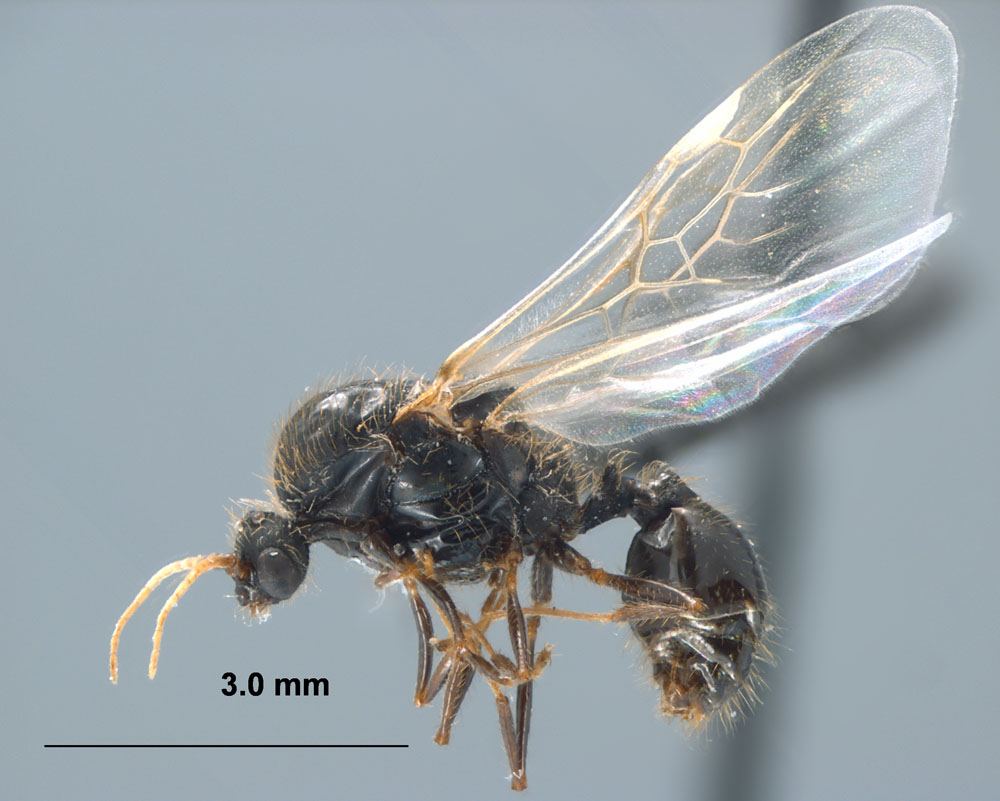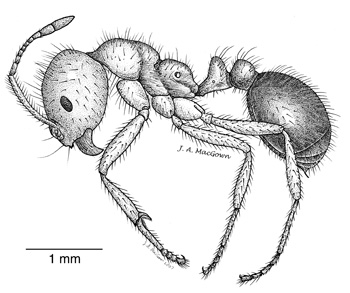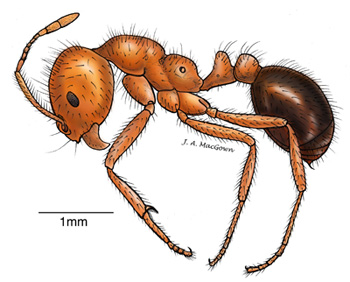Subfamily MYRMICINAE Authors: Joe A. MacGown and Ryan J. Whitehouse |
||
Solenopsis invicta, full face view of minor worker (MS, George Co.) (photo by Ryan Whitehouse and Joe A. MacGown) |
Solenopsis invicta, lateral view of minor worker (MS, George Co.) (photo by Ryan Whitehouse and Joe A. MacGown) |
Solenopsis invicta, dorsal view of minor worker (MS, George Co.) (photo by Ryan Whitehouse and Joe A. MacGown) |
Solenopsis invicta, full face view of major worker (MS, Holmes Co.) (photo by Ryan Whitehouse and Joe A. MacGown) |
Solenopsis invicta, lateral view of major worker (MS, Holmes Co.) (photo by Ryan Whitehouse and Joe A. MacGown) |
Solenopsis invicta, dorsal view of major worker (MS, Holmes Co.) (photo by Ryan Whitehouse and Joe A. MacGown) |
Solenopsis invicta, full face view of dealate queen (MS, George Co.) (photo by Ryan Whitehouse and Joe A. MacGown) |
Solenopsis invicta, lateral view of dealate queen (MS, George Co.) (photo by Ryan Whitehouse and Joe A. MacGown) |
Solenopsis invicta, dorsal view of dealate queen (MS, George Co.) (photo by Ryan Whitehouse and Joe A. MacGown) |
Solenopsis invicta, full face view of alate queen (AL, Bibb Co.) (photo by Ryan Whitehouse and Joe A. MacGown) |
Solenopsis invicta, lateral view of alate queen (AL, Bibb Co.) (photo by Ryan Whitehouse and Joe A. MacGown) |
Solenopsis invicta, dorsal view of alate queen (AL, Bibb Co.) (photo by Ryan Whitehouse and Joe A. MacGown) |
Solenopsis invicta, full face view of male (MS, Wayne Co.) (photo by Ryan Whitehouse and Joe A. MacGown) |
Solenopsis invicta, lateral view of male (MS, Wayne Co.) (photo by Ryan Whitehouse and Joe A. MacGown) |
Solenopsis invicta, dorsal view of male (MS, Wayne Co.) (photo by Ryan Whitehouse and Joe A. MacGown) |
Introduction Solenopsis invicta (Buren) (Myrmicinae), the Red Imported Fire Ant (RIFA), is a small bicolored red and blackish species native to Brazil. This species is well established in the souteastern US and has spread to Texas west to California. Solenopsis invicta is considered to be a serious stinging pest. Colonies may be polygynous and workers are polymorphic (varying sizes of workers). Solenopsis invicta, the scourge of the South, commonly referred to as the red imported fire ant (RIFA), has been the bane of many people in the deep south. These ants are more than a nuisance with their large mounds that dot the landscape, and are aggressive antagonists in a pitched battle for dominion of the open landscapes. Their stings are quite potent individually, but these ants attack en masse, and it is the lucky person who escapes with only one sting! The red imported fire ant is a major agricultural and urban pest throughout the southeastern states that causes both medical and environmental harm resulting in a cost of many millions of dollars per year for southeastern states. The red imported fire ant, is thought to have been introduced into the U.S. through either Mobile, Alabama or Pensacola, Florida, from Brazil sometime between 1933 and 1945. The red imported fire ant together with Solenopsis richteri, the black imported fire ant, which was introduced sometime near 1918, have wreaked havoc on the economy of the South. As if these two species were not bad enough, they both can mate with one another producing a hybrid, which is as bad or worse than either the black or red fire ant. Two native fire ants, S. geminata and S. xyloni, have not been collected in either MS or AL in many years and it is thought that the two imported fire ants and their hybrid have out-competed them for resources and effectively driven them out from this area. Generic level identification of Solenopsis is relatively straight forward, although sizes are greatly variable ranging from approximately 1.0 mm to over 4.0 mm. The genus can be basically characterized by the following: mandible with four teeth (usually), bicarinate clypeus with 0-5 teeth, median part of clypeus with a pair of longitudinal carinae medially or at lateral edges, 10-segmented antennae that terminates in a distinctive 2-segmented club, overall shiny appearance and general lack of or reduced sculpture (when present usually restricted to rugulae or striae on the head, alitrunk, petiole, and postpetiole), lack of propodeal spines or other protuberances on the alitrunk, well developed petiole and postpetiole, and a well-developed sting. Workers are either polymorphic (especially in the fire ant group) or monomorphic (especially thief ants). Hybridization is not uncommon among the larger fire ant group, which can make identification of some species difficult. Identification of thief ants is perhaps even more challenging due to their minute size, similar appearance of workers of one species to another, taxonomic problems, and lack of knowledge of all castes. Taxonomic History (Bolton 2016) Diagnosis Identification Minor Worker: HL 0.68-–087 mm, HW 0.57–0.70 mm, SL 0.59–0.69 mm, EL 0.13–0.18 mm, MeSL 0.79–0.97 mm (n=5) (MEM specimens). Light brown to reddish brown ant, sometimes with a uniformly, darker colored gaster. Head oblong without a median indentation along the occipital border. The rest of the identification matches that of the major worker just with everything smaller in size. Queen: Large (TL ≈ 7.0–7.5 mm, HL 1.25–1.38 mm, HW 1.29–1.38 mm, SL 0.95–1.04 mm, EL 0.45–0.48 mm, MeSL 2.54–2.76 mm) (n=5) (MEM specimens). Head, mesosoma, waist, antennae, and legs reddish brown; gaster brownish black, often the anterior portion of first tergite with some light reddish brown coloration. Head about as wide as long, rounded square; smooth and shining with scatterred erect setae; eyes large and situated laterally at the midpoint of the head; three ocelli present; antennae 11-segmented with a 2-segmented club; clypeus tridentate, median tooth minute, with two anteriorly diverging carinae; mandibles with 4 teeth. Mesosoma rounded rectangular, almost square, with mesoscutum rounded anteriorly; mostly mooth and shining except some striae present on anterior portion of mesoscutellum and propodeum with numerous transverse striae; numerous erect setae present dorsally and on propodeum, but sparse on pronotum and mesopleura; dorsal surface relatively flat; four wings or wing scars present; propodeum unarmed; declivity straight, almost 90°. Wings clear with light amber colored viens; forewing with costal, basal, subbasal, submarginal, and discal cells presesnt, pterostigma present; hindwing with costal, basal, and anal cells present. Waist 2-segmented, notes; petiolar node narrower than the postpetiolar node in lateral view. Gaster shining with long erect setae; sting present. Male: Medium sized, larger than workers (TL ≈ 6.0 mm, HL 0.83–0.85 mm, HW 0.86–0.88 mm, SL 0.17–0.18 mm, EL 0.48–0.49 mm, MeSL 2.60–2.72mm) (n=2, MEM specimens). Head, mesosoma, waist and gaster blackish; scape and pedicel brown, remainder of funiculus yellow brown; legs dark brown. Head small compared to the mesosoma, circular; shiny with course rugae anteriorly fading to dense punctation posteriorly, clypeus mostly lacking sculpture; with numerous long, erect, whitesh colored setae present; eyes large, more than twice the head length, located on the anterior half of the head; three large ocelli present; frontal carina reduced; antennae 12-segmented, scape subequal to antennae segments 3-12; second antennal segment (pedicel) short, ovoid; mandibles small, with 2 teeth. Mesosoma bulky, elliptical in lateral view; mostly mooth and shining except some striae present on anterior portion of mesoscutellum and propodeum with dense punctation; entire mesosoma with numerous erect, elongate, whitesh setae present; propodeum unarmed. Wings clear with light amber colored viens; forewing with costal, basal, subbasal, submarginal, and discal cells presesnt, pterostigma present; hindwing with costal, basal, and anal cells present. Waist 2-segmented, both nodes with dense, fine punctation; petiolar node with a dorsal median notch. Gaster shiniy, with numerous erect, light colored setae, especially posterially genitalia visible at the apex. Biology Pest Status Fire ants are most common in urban areas, where they nest in open, disturbed sites such as lawns, fields, roadsides, or other similar situations. Because fire ants thrive in urban areas, their presence may be a deterrent to outdoor activities. Most people’s interaction with fire ants comes from getting stung. When their colony is disturbed, S. invicta workers swarm out searching for the cause of the disturbance, then numerous individuals aggressively sting the intruder. Because of the voracity of attacks and the number of stings received, victims may develop an allergy to their venom and potentially require medical treatment. Stings often result in itching red bumps that in many individuals forms hardened pustules that eventually dissapate. Fire ants are capable of inflicting serious injury or killing various animals, especially weak or sick individuals. Nests are sometimes built under structures such as pavements and foundations, where they may cause structural problems, even occasionally causing structures to collapse. Red imported fire ants also are known to damage equipment and infrastructure, which may cause negative impacts on businesses and affect property values. Workers are apparently attracted to electricity and have been reported to short out electrical equipment. This species is a serious agricultural pest that invades and damages a variety of crops. Large mounds on farmland can damage machinery and affect harvesting. Although fire ants are generally considered to be a serious pest species, they are beneficial at times as they consume large amounts of other insects, including many pest species. Distribution Australian: Australia, Hawaii (AntWiki.org). U.S. Distribution: AL, AR, CA, FL, GA, IL, LA, MO, MS, NC, NM, OK, SC, TN, TX, VA (AntWeb.org, AntWiki.org and MEM). Acknowledgments Literature Cited Bolton, B. 1995. A new general catalogue of the ants of the world. Cambridge, Mass.: Harvard University Press, 504 pp. Bolton, B. 2016. Bolton World Catalog Ants. Available online: http://www.antweb.org/world.jsp. Accessed 9 March 2016. Buren, W. F. 1972. Revisionary studies on the taxonomy of the imported fire ants. Journal of the Georgia Entomological Society 7:1-26. Shattuck, S. O.; Porter, S. D.; Wojcik, D. P. 1999. Case 3069. Solenopsis invicta Buren, 1972 (Insecta, Hymenoptera): proposed conservation of the specific name. Bulletin of Zoological Nomenclature 56:27-30. Smith, D. R. 1979. Superfamily Formicoidea. Pp. 1323-1467 in: Krombein, K. V.; Hurd, P. D.; Smith, D. R.; Burks, B. D. (eds.) 1979. Catalog of Hymenoptera in America north of Mexico. Volume 2. Apocrita (Aculeata). Washington, D.C.: Smithsonian Institution Press, pp. i-xvi, 1199-2209. Trager, J. C. 1991. A revision of the fire ants, Solenopsis geminata group (Hymenoptera: Formicidae: Myrmicinae). Journal of the New York Entomological Society 99:141-198. Wheeler, G. C.; Wheeler, J. 1977. Supplementary studies on ant larvae: Myrmicinae. Transactions of the American Entomological Society 103:581-602. Links Other Imported Fire Ant Links: |
||



